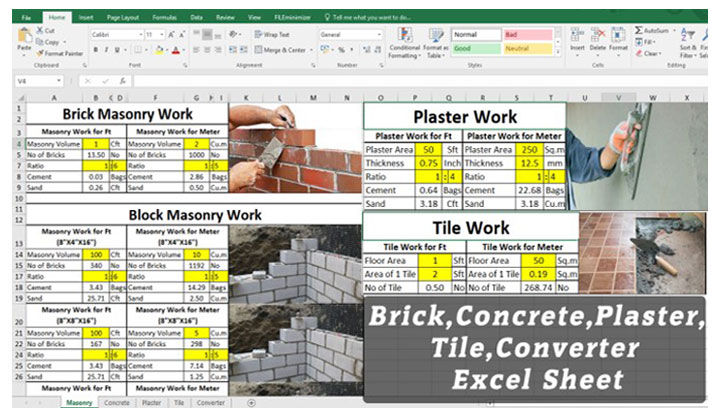Hi there, folks! Today we are here with another free spreadsheet for you to download. This all-in-one excel sheet is very useful in converting Brick Masonry Work, Concrete Work, Plaster Work, Tile Work, Unit Conversion.
The most basic building unit known to humankind is a brick, which has been in use since the dawn of history. It is available in a very particular rectangular block shape, whose length must be twice its width. The height of the brick may differ from place to place, though.
Commonly, the normal bricks found in most countries around the world are 9 inches by 4.5 inches by 3 inches. This is called the nominal size of a brick, however, other shapes and sizes of bricks are also used in some places.
The above is true for standard bricks, but there are other kinds of building blocks that serve the same purpose with better functions, which can be of different shapes.
The trade of laying bricks in mortar systematically and homogenously is called brick masonry. Properly done, brick masonry can last hundreds of years, withstanding lots of structural loads without taking damage.
Brickwork or masonry can be defined by two kinds of final per unit measurements, called nominal dimensions and architectural dimensions. The nominal dimensions of a brick are 225 mm by 112.5 mm by 75 mm, but the architectural or working dimensions of a brick are 215 mm by 102.5 mm by 65 mm.
The difference between the sizes comes from the amount of mortar that must be placed with the brick to stabilize it. The nominal or coordinating dimension of a brick is the actual brick and the mortar surrounding it. That is, mortar on three faces – bed, header and stretcher.
However, we have to remind ourselves that it is very hard to make a brick of a perfect size. During manufacturing, many factors affect the size of a brick; shrinkage, distortion when drying out, firing etc. These factors combine to make each batch of brick slightly different from another batch. However, this difference is made up for when mortar is applied to the bricks and pressed on. Some approximation at the edges of the wall is always expected.
There are two ways a couple of bricks can be joined together – vertically or horizontally. A bed is the mortar placed horizontally below bricks to join them (or the beam/slab) vertically. And the mortar placed in-between bricks laying on the same bed side-by-side is called prepend, that joins them horizontally. Therefore, one brick has at least four mortar joints going with it.
To be considered a properly built masonry wall worth the investment, it has to stand up to the following factors:
Why should you worry about concrete mix design? Because it makes the structural support members that hold the whole building together without a properly planned concrete mix design, the structural supports may collapse under load, and thereby bring down the whole building.
Download link: https://drive.google.com
